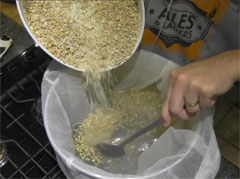This past summer, I asked my wife, Susan, what I should brew next. She suggested a blackberry Pilsner. I had never heard of such a thing, but in the interest of keeping her happy and tolerant of my hobby/occupation, I decided to give it a go.
I put “Pilsner” in quotation marks in the title of this recipe for a couple of reasons. First of all, those who abide by the Reinheitsgebot – the beer purity law – would cringe at the thought of adding fruit to this classic German style. Blackberries definitely fall outside the malt, hops, water and yeast list. Second, Pilsners are traditionally lagered to brew a beer of clean profile with no fruity yeast characteristics. It didn’t make sense to me to go to the trouble of fermenting cold to avoid fruity flavors to then add some fruit afterwards. So, I fermented this beer with lager yeast at ale fermentation temperatures.
I wanted to keep the base beer recipe very simple. This was a two-gallon (7.5 L) batch brewed with the Brew in a Bag technique. To three gallons (11.4 L) of water in my bag-lined kettle, I added four pounds (1.8 kg) German Pilsner malt and mashed at 150˚F (65˚C) for one hour. At the beginning of my one-hour boil, I added 14 grams of Saaz hops and another 14 grams of Saaz at flameout. I fermented at room temperature with a packet of Saflager S-23. Original gravity was 1.051. Final gravity reached 1.012, giving the base beer an ABV of 5.1%.
After primary fermentation of one week, I racked the beer to a Mr. Beer fermenter, where I added 30 ounces (850 grams) thawed, frozen blackberries, crushing them first with a large slotted spoon. There they sat for another week.
Bottling the beer with the Mr. Beer fermenter keg turned out to be very easy. The fruit floated to the top, allowing me to use the spigot to bottle the beer from underneath. I primed with priming sugar tablets.
The resulting beer is very fruity with a prominent pinkish hue. The blackberries came out tasting very fresh and bright against the fairly neutral base beer. I didn’t detect any off flavors from fermenting the lager yeast at ale temperatures. In an episode of Basic Brewing Video (below), Steve Wilkes and I paired the beer with sous vide fruit, which was a great success.
I’d like to revisit this recipe and try other fruit additions. I might try using a grain bag for the fruit, so I can squeeze some of the beer out of the floating fruity remains.
Blackberry “Pilsner”
2 gal. (7.5 L) Batch
4 lbs. (1.8 kg) German Pilsner Malt
14 g Saaz Pellets – 60 min.
14 g Saaz Pellets – Flameout
Saflager S-23 Yeast
30 oz. (850 g) Thawed frozen blackberries (added in secondary)
OG: 1.051 FG: 1.012 ABV: 5.1%
(gravity readings of base beer before adding fruit)




how different would it be if the fruit was added at flameout instead of secondary? Last fall I did a Cherry bock – sort of a Red-X/ Hallaertau SMaSH with a quart of tart cherry juice added to about 2.5 gallons at flameout. What would result if I just added juice/fruit to primary ( I only have one fermenting bucket 😉 )
When I made your Cranberry Zinger last fall …. I lined the 2ndry LBK with a 5G paint-strainer bag into which I placed the 2.5# of “hand-cranked food mill” processed cranberries … then racked the beer onto the fruit.
Twisted and stuffed the bag’s excess material into the keg (worked well with my red raspberry wheat … too).
Bottled a week later.
Cracked the 1st one a month later.
Quite tasty … as advertised.
—
BTW … the LBK can handle 2.5G (9-L) batches.